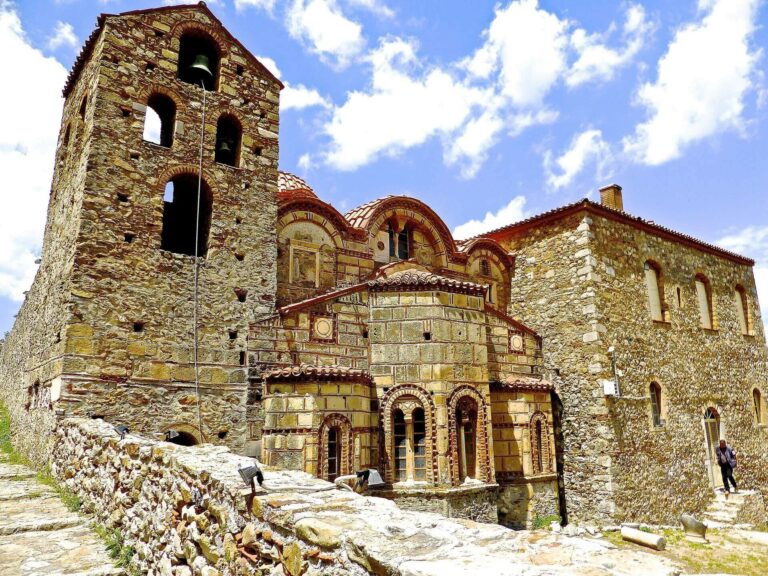Wandering through Mystras’ stone-paved lanes, the scents from local eateries immediately caught my attention. The town seemed to be a showcase of Greek culinary art, with each meal offering a unique combination of tastes and textures. Dishes like the flavorful souvlaki and the complex moussaka are prime examples of Greek cuisine’s depth. Yet, these popular choices are just the beginning. Let’s delve deeper into Mystras’ food scene to discover the exceptional and unexpected delights that embody the essence of this historic location.
In Mystras, the traditional Greek souvlaki is more than just skewered meat; it’s a juicy, herb-infused delicacy that reflects the region’s fresh produce and time-honored cooking methods. Similarly, moussaka isn’t merely a casserole but a layered harmony of eggplant, spiced meat, and creamy béchamel that showcases the balance of Greek flavors. Beyond these classics, local cheese varieties like feta and myzithra add a tangy richness to salads and pies, illustrating the area’s dairy craftsmanship.
Culinary explorers should also seek out the less-known but equally mouthwatering specialties such as dakos, a rusk-based dish topped with tomato and cheese, signifying Mystras’ connection to the broader Mediterranean palate. Local honey and olive oils, staples of the Peloponnesian diet, are not only ingredients but culinary treasures, each telling a story of the region’s fertile land and history of agriculture.
Understanding these elements of Mystras’ cuisine provides insight into the cultural and historical significance behind every bite. It’s not just about eating; it’s about experiencing a piece of Greek heritage that has been preserved and continues to thrive in the kitchens of Mystras. So, as we embark on this flavor-filled journey, expect to uncover the true spirit of Greek gastronomy, one dish at a time.
Souvlaki: A Greek Classic
Souvlaki is a cherished dish in Greece, known for its savory grilled meat, aromatic herbs, and zesty tzatziki sauce. This dish reigns supreme as the quintessential Greek street food and is deeply rooted in the nation’s culinary traditions. The mere thought of souvlaki excites the senses, with images of biting into tender, herb-seasoned meat. The enticing smell of meat grilling captivates anyone nearby, promising a satisfying meal.
The distinct flavor profile of souvlaki is a testament to Greek culinary artistry. The meat’s smoky crust, moist interior, and the herbal freshness blend in a delightful taste medley. The crowning touch, tzatziki sauce, made with rich Greek yogurt, crisp cucumber, bold garlic, and fragrant dill, introduces a cool, vibrant contrast to the warm spices.
Souvlaki captures the essence of Greek street food culture, embodying the joy of casual dining. Its convenience makes it ideal for on-the-move eating, allowing diners to enjoy the vibrant atmosphere of Greek streets. With options like marinated pork, chicken, or a selection of grilled veggies, souvlaki caters to all preferences, making it a universally appealing dish.
Moussaka: Layers of Flavor
Moussaka offers a true exploration of Greek culinary traditions, layering eggplant, potatoes, and finely ground lamb or beef, all crowned with a silky béchamel sauce. This dish is a cornerstone of Greek home cooking and has earned its place on my own menu as I delve deeper into the flavors of Greece.
This robust, casserole-style entrée is built with layers of succulent eggplant, hearty potatoes, and savory minced meat. Once assembled, the dish is finished with a luxurious béchamel sauce and baked to a perfect golden-brown crust. The harmony of savory and spice in Moussaka is nothing short of heavenly.
Moussaka’s versatility shines when it caters to various diets. A vegetarian version might substitute lentils or mushrooms for the meat, offering a dish that remains indulgent and fulfilling.
A key to Moussaka’s distinct taste is the careful selection of spices and herbs. Greek cuisine is known for its use of cinnamon, nutmeg, and oregano, which lend a warm complexity to the dish. Meanwhile, herbs such as parsley and mint infuse it with a burst of freshness. These elements combine to create an indelible taste experience.
Moussaka is a celebration of flavor and texture that both meat enthusiasts and vegetarians should experience. It embodies the essence of Greek dining and is a testament to the rich culinary culture of Greece.
Spanakopita: A Spinach Delight
Spanakopita is a savory Greek treat that marries the rich taste of spinach with the crisp texture of phyllo pastry. This dish is a cornerstone of Greek gastronomy, cherished by both residents and visitors. Here’s why you should sample spanakopita in Mystras:
- Heritage of Greek cuisine: Spanakopita represents the enduring culinary traditions of Greece, reflecting the nation’s preference for natural and nutritious ingredients. Its long-standing presence on Greek tables highlights the country’s culinary history.
- Spinach’s nutritional value: As a powerhouse of nutrients, spinach is renowned for its health advantages. It’s a bountiful source of vitamins A, C, and K, along with minerals like iron and calcium, and is rich in fiber. Enjoying spinach through spanakopita is a tasty way to enjoy these nutrients.
- Harmony of tastes and textures: Spanakopita offers an ideal mix of the wholesome taste of spinach with the golden, buttery phyllo sheets. Each forkful is a blend of taste and texture, tempting you to savor more.
In Mystras, spanakopita isn’t just food; it’s a reflection of Greek hospitality and culinary expertise. When you bite into this pastry, you’re experiencing a piece of Greek culture, crafted from family recipes passed down through generations. This isn’t just a meal; it’s a cultural immersion, a blend of history and gastronomy.
Tzatziki: Creamy and Refreshing
In Mystras, my journey through delightful local cuisine brings me to the classic tzatziki. This traditional Greek sauce combines the creamy richness of Greek yogurt with the crispness of cucumber, the aromatic punch of garlic, and the herbaceous notes of dill or mint. Tzatziki’s cool, slightly tangy taste complements grilled dishes, fresh vegetables, and pita bread superbly.
The beauty of tzatziki lies in its adaptability. Chefs and home cooks alike can adjust the ingredients to preference, creating countless variations. Some may prefer an assertive garlic presence for a robust flavor, while others may choose a subtler touch. Fresh dill or mint enhances the tzatziki with a fragrant lift, making each spoonful a refreshing experience.
For outstanding tzatziki, selecting top-tier ingredients is crucial. Opt for a dense, rich Greek yogurt and thoroughly drain the grated cucumber to maintain a thick, non-watery consistency. A dash of lemon juice not only elevates the zestiness but also preserves the sauce’s freshness.
Tzatziki is a culinary gem in Mystras. The harmonious balance of its creamy and zesty flavors is truly addictive. Whether sticking to the original or experimenting with your own take, this dish is a testament to Greek gastronomy’s simple yet sophisticated charm.
Baklava: A Sweet Sensation
Baklava: A Sweet Sensation
Baklava, a delightful Mediterranean pastry, captivates the senses with its flaky phyllo layers, sweet honey, and a rich mix of nuts and spices. This dessert hails from Greece, where it’s a celebrated part of the local cuisine. If you’re sampling sweets in Mystras, baklava is an essential treat.
Greek pastries: a culinary tradition:
Greek food is famous for its delicious pastries, and baklava stands out among them. With a history that stretches back generations, it’s a cornerstone of Greek dessert making. Families often have their own baklava recipes, which show the deep cultural roots of this confection.
Exploring local desserts:
In Mystras, you should dive into the local sweets. Alongside baklava, you’ll find loukoumades, deep-fried dough balls drenched in honey, and galaktoboureko, a pastry oozing with creamy custard. Each sweet has a unique flavor and texture that showcases the region’s culinary diversity. Tasting them all helps you find the one you love most.
Baklava combines crisp phyllo, sweet syrup, and nuts in a perfect treat that reflects Greek culinary heritage. It’s a top choice for anyone eager to try Mystras’s desserts. So indulge in a piece of baklava and let its taste take you to the Mediterranean’s heart.
Loukoumades: Pillows of Pleasure
Loukoumades are a delightful Greek sweet, akin to bite-sized clouds that dissolve delightfully on your tongue. These small delights consist of a straightforward, divine blend of dough, which is deep-fried until it achieves a golden hue, then finished with a generous helping of authentic Greek honey. Their status as a cherished conventional sweet throughout Greek history is well-deserved.
When you bite into a loukoumada, the first thing you’ll notice is the crunchy shell that opens up to a tender, airy interior. The dough carries a subtle sweetness, enhanced with a sprinkle of cinnamon, and the addition of Greek honey introduces a floral sweetness that enriches the dough’s flavor. Each mouthful presents a rich tapestry of taste and texture, combining sweetness with a feather-light touch.
The charm of loukoumades extends beyond their irresistible flavor; it’s the experience they offer. Imagine sitting in a quaint taverna in Mystras, basking in the gentle Mediterranean sunlight. With every nibble of these exquisite morsels, you connect with the profound gastronomic heritage of Greece, feeling a sense of liberation and tradition.
Loukoumades not only captivate your palate but also transport you to the heart of Greek culture, where culinary expertise has been honed over centuries. These delectable sweets are a testament to the enduring legacy of Greek cuisine, offering a taste that’s both timeless and boundlessly enjoyable.








